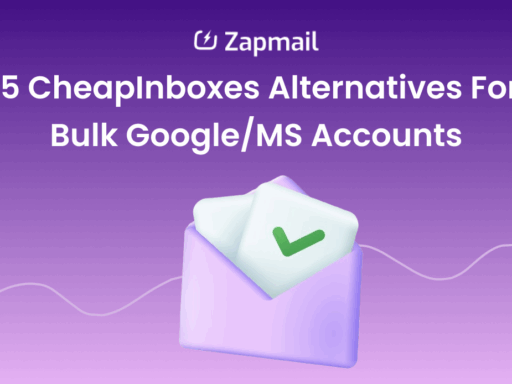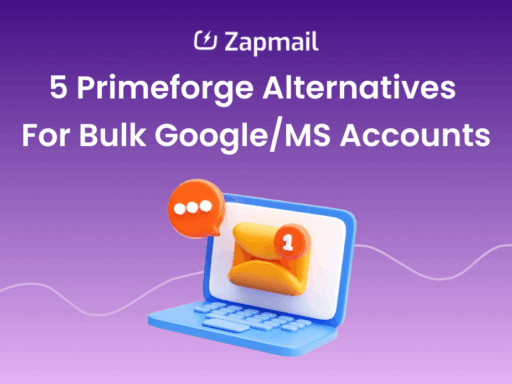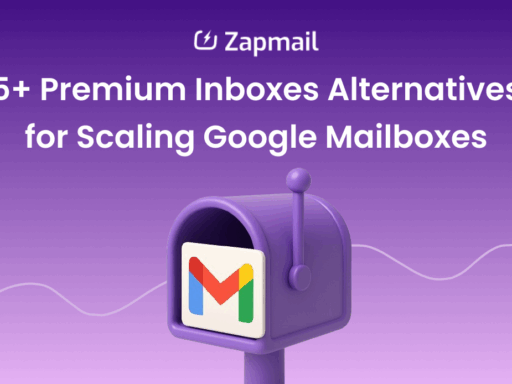If you’re running outbound campaigns, you’ve likely come across CheapInboxes. It’s pitched as a fast and inexpensive way to spin up bulk inboxes.
But how well does it actually hold up once you move past a handful of accounts?
You might be asking:
- Does CheapInboxes make inbox setup truly effortless?
- How reliable is it when managing 20–30+ accounts at scale?
- What hidden costs or gaps appear after the low entry price?
- And is there a better alternative for teams focused on long-term deliverability?
In this review, we’ll cover CheapInboxes’ features, setup process, costs, and limitations and how it compares to its alternative, which we found more effective once scaling became the priority.
In this review, we’ll break down what “success” in outbound really means: warmup speed, inbox placement, reply rates, and the hidden workload so you can see why CheapInboxes worked for trials but Zapmail became our default for scale.
TL;DR: CheapInboxes Review Key Takeaways
- CheapInboxes is affordable, making it a solid option for short outbound tests and budget-first experiments.
- It works well under 30 inboxes, but scaling is difficult due to the lack of automated warmup, monitoring, and consistent inbox placement.
- Inbox performance can be unpredictable, and managing campaigns requires more manual oversight compared to alternatives.
- Pricing is attractive for small pilots, but it may not hold up well for larger or long-term sending needs.
- If you want reliability, monitoring, and automated warmup, Zapmail is the stronger long-term option.
What We Looked at to Review Cheapinboxes?
To keep this review balanced, we focused on the areas that matter most to teams evaluating an email infrastructure tool:
- We started with user feedback, paying attention to what people liked and the complaints that came up often.
- Then we reviewed its core features, like mailbox provisioning, domain setup, and deliverability basics.
- We checked the ease of setup to see how quickly inboxes can be created without extra technical work.
- Deliverability was another focus, including warmup support and whether SPF, DKIM, and DMARC are handled smoothly.
- We analyzed the scalability from the reviews, especially how daily send caps and inbox performance hold up at higher volumes.
- Finally, we considered support and usability, from onboarding to everyday use and customer service quality.
What is CheapInboxes?
CheapInboxes is a bulk Google Workspace reseller that offers low-cost business inboxes for cold email agencies and senders at scale.
Accounts are provisioned under Google Workspace Business, with pricing starting at $3.50 per inbox and dropping as low as $2.80 at higher volumes.
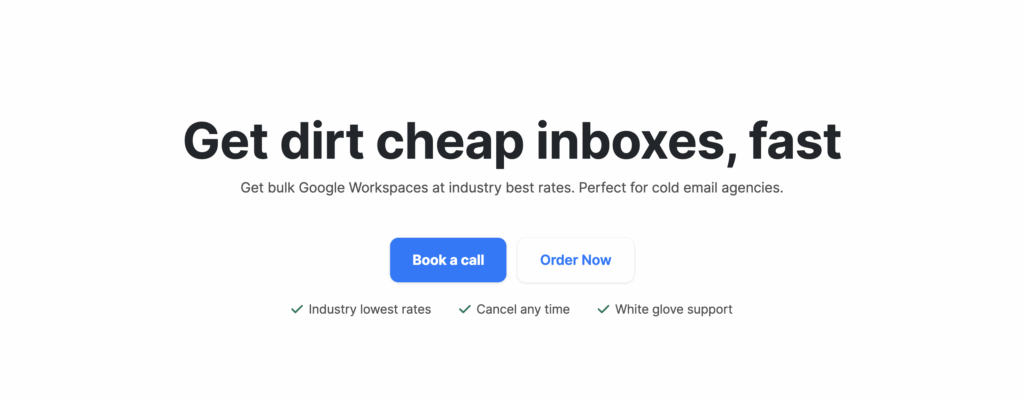
Setup is fast, with a typical turnaround of 24–48 hours, and each plan includes white-glove onboarding, full panel access, and support.
Agencies can order anywhere from a handful of inboxes to several thousand, depending on their needs.
At its core, CheapInboxes focuses on affordability and speed of provisioning, giving users large volumes of Google Workspace inboxes at wholesale prices.
How CheapInboxes Works (Setup & Delivery)
Here’s how CheapInboxes works:
Step 1: Select Total no. of Inboxes and Domains
Pick the number of inboxes and domains you need, then submit the order, there’s no technical setup required.
Step 2: Wait for Provisioning
CheapInboxes works on a 48-hour service window. In most cases, inboxes are delivered within two days, already connected to the domains you’ve specified.
Step 3: Access the Dashboard
Once provisioned, the inboxes appear in a straightforward dashboard. From here, you can view accounts and begin using them right away. The dashboard is functional but limited, just enough to centralize inbox access.
Step 4: Start your Campaign
With inboxes live, you can start sending. However, there’s no built-in warmup process. If you want to avoid spam filters, you’ll need to manually pace volumes or connect an external warmup tool before s`caling.
Step 5: Ongoing Monitoring
After sending begins, there’s no automated monitoring inside CheapInboxes. Tracking inbox placement, DNS health, or deliverability trends is left to outside tools or manual checks. This means you’ll only spot problems once results start slipping.
Most Relevant CheapInboxes Features
CheapInboxes keeps its feature set pretty lean. Here’s what stood out most when we tested it:
- Fast inbox provisioning
Bulk Google Workspace inboxes are set up within 24–48 hours and managed in a basic dashboard.
- Multi-account access
You can organize multiple inboxes with tags and simple permissions, though management feels limited at higher volumes.
- Domain setup basics
Branding is possible, but DNS records like SPF, DKIM, and DMARC aren’t automated, you’ll need to configure them manually.
- 48-hour delivery SLA
Support is ticket-based, with a standard 48-hour service window for inbox delivery.
In short, CheapInboxes gives you the basics to get started, fast provisioning, a dashboard, and minimal multi-account management. What really stands out is that CheapInboxes works well for small-scale trials or testing campaigns.
However, once you try to scale beyond a handful of inboxes, the manual setup and limited monitoring start to slow things down.
Teams looking for automated warmup, real-time deliverability tracking, and advanced domain management will find themselves needing a more robust solution.
And the advanced features you’d want for scaling (deep monitoring, automated warmup, stronger domain checks) aren’t built in.
CheapInboxes Pricing & Total Cost of Ownership
CheapInboxes look affordable, with inboxes starting at $3.50 each. But the actual cost depends on the plan and its minimum inbox requirement:
- Starter Plan: $3.50/inbox, no minimum (flexible but only for small runs).
- Business Plan: $3.25/inbox, 100 inbox minimum ($325/month).
- Agency Plan: $3.00/inbox, 250 inbox minimum ($750/month).
- Enterprise Plan: $2.80/inbox, 1,000 inbox minimum ($2,800/month).
For context, running 30 inboxes on Starter costs about $105/month in subscription fees.
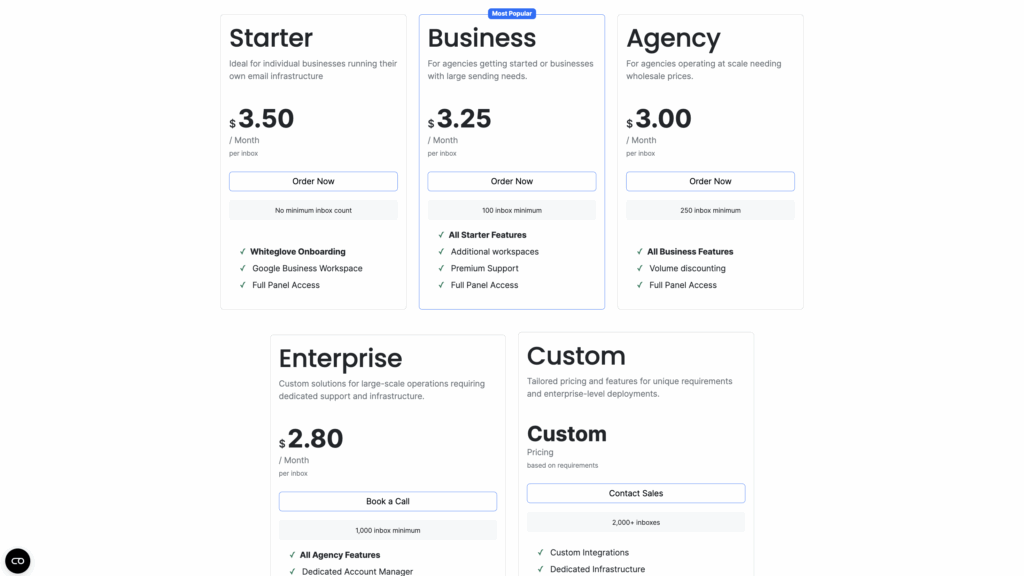
However, this only covers inbox access. Warmup, monitoring, and DNS management are not included, which means adding external tools or handling those tasks manually.
When factoring in these extras, the effective cost ends up higher than the subscription alone.
Note: Compared to CheapInboxes, where $105/month for 30 inboxes is just the starting point before adding warmup tools, monitoring, and extra ops costs, Zapmail’s $99 Growth Plan gives you 30 inboxes with everything built in.
What Users Appreciate About CheapInboxes
To be fair, CheapInboxes does deliver on the basics. Users consistently point to three things they like most:
- Low entry price: At just a few dollars per inbox, it’s one of the cheapest ways to get bulk accounts live, pricing often starts near $3.50/inbox and can drop to around $2.80 at scale.

- Fairly Quick setup: You can go from order to active inboxes in under 48 hours, so teams can test campaigns quickly without waiting weeks for provisioning.The process is mostly hands-off, with accounts delivered pre-configured and ready to log in, which saves time for teams that just want to launch without extra setup work.
- Minimal initial friction: There’s no steep learning curve, simple dashboard, straightforward handoff of logins, and little technical setup needed to start sending.
Complaints Users Have About CheapInboxes
That said, the same users also point out where the tool shows its limits:
That said, the same users also point out where the tool shows its limits:
- Manual warm-up & health babysitting. No built-in warm-up; you’ll need to throttle sends, monitor reputation, and/or pay for a separate warm-up tool.
- Inconsistent placement at scale. Fine with a handful of inboxes, but once you hit ~20–30+, more messages drift to Promotions or Spam.
- Limited visibility & alerts. If DNS is misconfigured or bounces spike, you may not know until replies slow down.
- Lack of transparency & track record: Best pricing, but there’s virtually no public info on who runs it; it only surfaced in Reddit posts recently, which raises trust and continuity concerns.

These trade-offs are why many teams start with CheapInboxes, but later outgrow it once outbound becomes more than a quick experiment.
Related Read- How to Improve Email Deliverability: Expert Tips
Who Should and Shouldn’t Use CheapInboxes
CheapInboxes does have a place in the outbound toolkit, but only for certain situations.
| CheapInboxes Is a Good Fit For | CheapInboxes Is Not a Fit For |
| Short pilots where speed matters more than long-term deliverability | Brand-sensitive programs where reputation and domain health must be protected |
| Budget-first experiments with very low upfront cost needs | Long-term outbound strategies needing consistent inbox placement |
| Low brand-risk projects where inbox burnout is acceptable | Teams scaling beyond 30–50 inboxes, where manual warmup and limited monitoring become bottlenecks |
In other words, CheapInboxes work best when you just need something quick and disposable. For teams focused on long-term outreach, relying solely on CheapInboxes can.
Manual warmup, limited monitoring, and basic domain setup mean more time spent troubleshooting instead of sending.
A platform with automated warmup, reputation management, and scaling tools will save effort and improve deliverability as campaigns grow.
But if you’re serious about scaling and protecting your domains, you’ll quickly find yourself looking for a more complete solution.
Zapmail: A Strong and Affordable Alternative to CheapInboxes
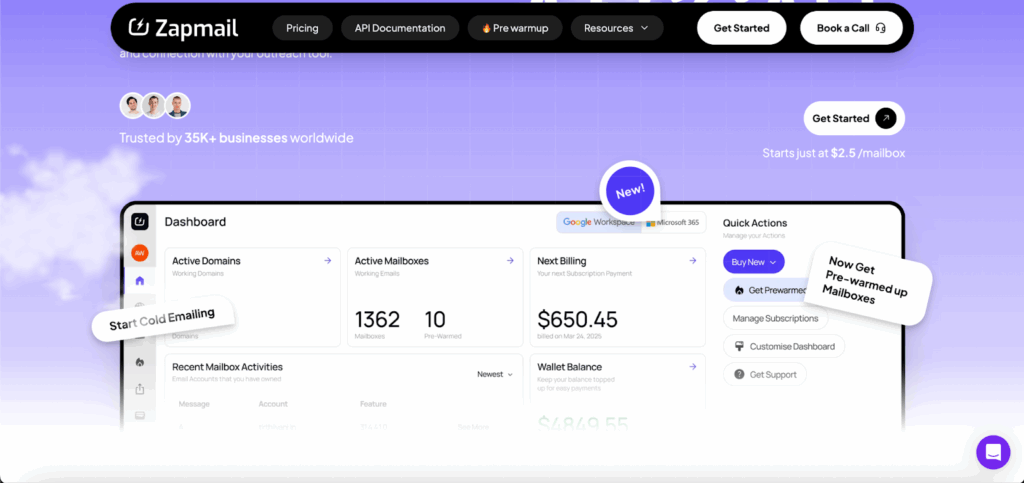
Unlike CheapInboxes, which focuses mainly on low-cost provisioning, Zapmail offers fast setup process and affordable Google & Microsoft mailboxes along with you have option to buy pre-warmed accounts.
Here are the key features:
Ready to use mailboxes
Google Workspace and Microsoft 365 accounts come set up and warmed, so you can start campaigns without extra prep.
Automated DNS & Tracking
SPF, DKIM, and DMARC are configured automatically, with custom tracking domains included for clean deliverability.
Workspace-Level Isolation
Each domain runs in its own workspace with admin access, reducing ban risk and keeping inboxes organized.
Visibility Into Deliverability
Built-in monitoring tracks placement, blocklists, and domain health so you know if something’s off before it impacts sending.
Quick Set-up From One Mailbox to Hundreds
Setup takes minutes, and scaling across 50 or 100+ inboxes is managed with templates, rotation rules, and workspace tools.
50+ Integrations
Connect directly to outreach platforms like Lemlist, Instantly, Smartlead, and Reply without extra setup.
Support & SLAs
CheapInboxes offers ticket-based support and a 48-hour SLA for inbox delivery.
Zapmail delivers faster setup (5–10 minutes per inbox), white-glove onboarding, and priority support options in higher plans.
CheapInboxes is a budget-friendly option if you just need mailboxes fast, while Zapmail is built for teams that want scale, reliability, and long-term deliverability baked in.
Zapmail vs. CheapInboxes: Side-by-Side
Here’s how CheapInboxes and Zapmail compare across the areas that matter most for outbound teams:
| Aspect | CheapInboxes | Zapmail |
| Setup & Onboarding | Fast, minimal | Fast (5-10 min per inbox) plus guided onboarding with pre-configured settings (DNS, sending limits, warmup presets) so accounts are production-ready out of the box |
| Warmup & Health | Manual, external tools | Automated, throttled, health scoring |
| Monitoring | Basic placement checks | Seeds, spam traps, blocklists, alerts |
| Scaling | Manual sender rotation | Guardrails, templates, safety caps |
| Analytics | Limited reporting | Per-domain and per-sender dashboards |
| Support | Basic ticketing | Hands-on onboarding, clear SLAs |
| Pricing Model | Low entry price | Low entry price |
| Best Fit | Cheap pilots | Scalable, brand-sensitive outbound programs |
CheapInboxes is a low-cost, fast option for quick tests or short-term campaigns — but it has a minimum mailbox limit and lacks automation, monitoring, and safeguards, making scaling risky.
Zapmail, by contrast, is built for long-term, high-volume outreach. With automated warmup, real-time monitoring, and deliverability safeguards, it protects domain reputation while helping teams grow from a handful of inboxes to 100+.
Conclusion
CheapInboxes works if you just need low-cost inboxes for short pilots. It delivers quick setup at a budget price, but scaling comes with real drawbacks:
- Manual warmup
- Limited monitoring
- Minimal domain protection
- Minimum inbox purchase required
CheapInboxes is fine for small tests, but once you hit 30+ inboxes, the limitations become clear.
Zapmail is a stronger alternative:
- Automated warmup with no manual setup
- Real-time deliverability monitoring and detailed analytics
- Centralized dashboard to manage 30, 50, or 100+ inboxes efficiently
- Stronger safeguards to protect domain reputation in high-volume outreach
In short, CheapInboxes covers basic testing needs, but Zapmail gives you the automation, insights, and scalability to grow without compromising deliverability.
Get Started With Zapmail Now!
FAQs
Q. Can we reuse the same domains?
Yes but reuse carefully. Zapmail automates warmup and checks, though fresh domains are still recommended as you scale.
Q. Safe daily volumes by Week 1–3?
Start at 20–30/day Week 1, double Week 2, then ramp to 100+. Zapmail automates this to prevent overstepping.
Q. How quickly can we scale to 100+ senders?
CheapInboxes is manual; Zapmail’s presets and guardrails let you scale in weeks without hurting deliverability.
Q. Do we still need third-party warmup tools?
No. Zapmail has built-in automated warmup, unlike CheapInboxes.
Q. What happens if a sender gets flagged?
Zapmail alerts you, scores reputation, and throttles volume automatically to protect your domains.
